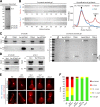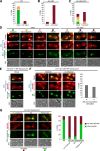A TOGL domain specifically targets yeast CLASP to kinetochores to stabilize kinetochore microtubules
- PMID: 24862575
- PMCID: PMC4033772
- DOI: 10.1083/jcb.201310018
A TOGL domain specifically targets yeast CLASP to kinetochores to stabilize kinetochore microtubules
Abstract
Cytoplasmic linker-associated proteins (CLASPs) are proposed to function in cell division based on their ability to bind tubulin via arrayed tumor overexpressed gene (TOG)-like (TOGL) domains. Structure predictions suggest that CLASPs have at least two TOGL domains. We show that only TOGL2 of Saccharomyces cerevisiae CLASP Stu1 binds to tubulin and is required for polymerization of spindle microtubules (MTs) in vivo. In contrast, TOGL1 recruits Stu1 to kinetochores (KTs), where it is essential for the stability and tension-dependent regulation of KT MTs. Stu1 is also recruited to spindle MTs by different mechanisms depending on the mitotic phase: in metaphase, Stu1 binds directly to the MT lattice, whereas in anaphase, it is localized indirectly to the spindle midzone. In both phases, the activity of TOGL2 is essential for interpolar MT stability, whereas TOGL1 is not involved. Thus, the two TOGL domains of yeast CLASP have different activities and execute distinct mitotic functions.
© 2014 Funk et al.
Figures









Similar articles
-
An isolated CLASP TOG domain suppresses microtubule catastrophe and promotes rescue.Mol Biol Cell. 2018 Jun 1;29(11):1359-1375. doi: 10.1091/mbc.E17-12-0748. Epub 2018 Apr 5. Mol Biol Cell. 2018. PMID: 29851564 Free PMC article.
-
Stu1 inversely regulates kinetochore capture and spindle stability.Genes Dev. 2009 Dec 1;23(23):2778-91. doi: 10.1101/gad.541309. Genes Dev. 2009. PMID: 19952112 Free PMC article.
-
Slk19 enhances cross-linking of microtubules by Ase1 and Stu1.Mol Biol Cell. 2021 Nov 1;32(21):ar22. doi: 10.1091/mbc.E21-05-0279. Epub 2021 Sep 8. Mol Biol Cell. 2021. PMID: 34495712 Free PMC article.
-
Factors that Control Mitotic Spindle Dynamics.Adv Exp Med Biol. 2017;925:89-101. doi: 10.1007/5584_2016_74. Adv Exp Med Biol. 2017. PMID: 27722958 Review.
-
The role of TOG domains in microtubule plus end dynamics.Biochem Soc Trans. 2009 Oct;37(Pt 5):1002-6. doi: 10.1042/BST0371002. Biochem Soc Trans. 2009. PMID: 19754440 Review.
Cited by
-
GSK3-mediated CLASP2 phosphorylation modulates kinetochore dynamics.J Cell Sci. 2017 Apr 15;130(8):1404-1412. doi: 10.1242/jcs.194662. Epub 2017 Feb 23. J Cell Sci. 2017. PMID: 28232523 Free PMC article.
-
An unconventional TOG domain is required for CLASP localization.Curr Biol. 2023 Aug 21;33(16):3522-3528.e7. doi: 10.1016/j.cub.2023.07.009. Epub 2023 Jul 28. Curr Biol. 2023. PMID: 37516114 Free PMC article.
-
An isolated CLASP TOG domain suppresses microtubule catastrophe and promotes rescue.Mol Biol Cell. 2018 Jun 1;29(11):1359-1375. doi: 10.1091/mbc.E17-12-0748. Epub 2018 Apr 5. Mol Biol Cell. 2018. PMID: 29851564 Free PMC article.
-
Synergistic stabilization of microtubules by BUB-1, HCP-1, and CLS-2 controls microtubule pausing and meiotic spindle assembly.Elife. 2023 Feb 17;12:e82579. doi: 10.7554/eLife.82579. Elife. 2023. PMID: 36799894 Free PMC article.
-
Structures of TOG1 and TOG2 from the human microtubule dynamics regulator CLASP1.PLoS One. 2019 Jul 19;14(7):e0219823. doi: 10.1371/journal.pone.0219823. eCollection 2019. PLoS One. 2019. PMID: 31323070 Free PMC article.
References
Publication types
MeSH terms
Substances
LinkOut - more resources
Full Text Sources
Other Literature Sources
Molecular Biology Databases

